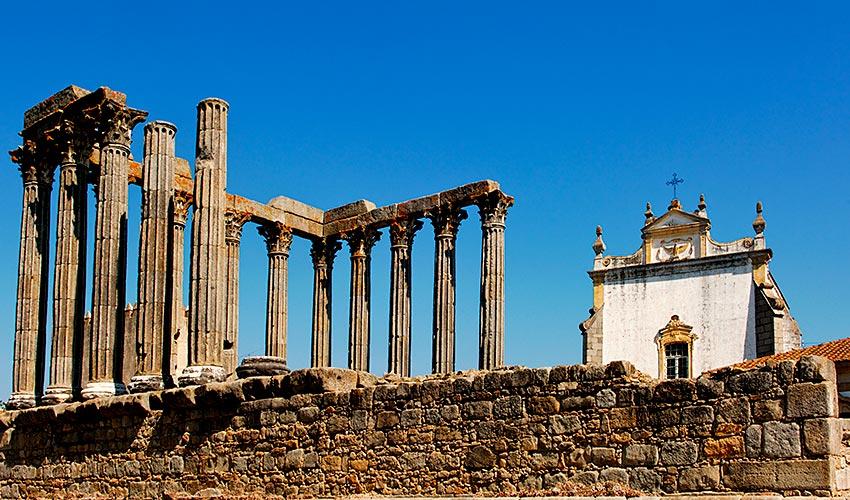History has made Evora one of the world’s most beautiful cities. It owes its name, Ebora, to the Celts. The Romans constructed its most glorious temple in honour of emperor Augustus and the Portuguese nobility built stately palaces alongside chapels, convents, churches and the majestic Gothic cathedral. Traces of different eras and civilisations have been left virtually untouched in a city where people still walk small cobbled, medieval streets. Large archways give way to picturesque squares where local artisan shops are found next to contemporary high-street brands. Terraced cafés invite you to relax while bars and restaurants offer a special gastronomic voyage through this southern part of Portugal. Leave the complications of the modern world behind and embrace the charm of Evora, Alentejo’s most romantic city!
The beauty of old and the vibrancy of new.
Witness Evora’s Roman history in the Temple of Diana or wander around the Moorish part of town in the north. One of the main highlights of Evora is the Chapel of Bones, where the hundreds of human bones exposed on its walls and ceilings will surely leave a mark on your memory. The large amount of rich monuments found in this city has led to its UNESCO classification as the ‘the finest example of a city of the golden age of Portugal after the destruction of Lisbon by the earthquake of 1755’.
This magnificent city is home to hundreds of young students who rush to attend class in the second oldest university in the country. Evora is kept young and vibrant by each one of them, arriving as they do from all over the country and from other places in the world. Throughout the day, cafés, bars and shops see numerous people coming and going. As night falls, streets light up and bars and clubs play a variety of music. The many students animate the streets of this historical city, making Evora one of the liveliest nightlife spots in the country!
The charm of an unspoilt region!
The city of Evora is situated in the charming region of the Alentejo, a land of endless golden fields dotted by olive and cork oak trees. In this spectacular part of Portugal, historical towns and picturesque villages nestle at the feet of medieval walls while local artisans uphold timeless traditions. The Alentejo offers the perfect escape for those who wish to explore the rich legacy left by Romans and Moors or delight in the typical local gastronomy while enjoying the peace of a wonderful landscape.
Many of the region’s main attractions lie just outside Evora. On the road to Montemor-o-Novo visit the Escoural Cave with its Palaeolithic drawings dating from around 25,000 B.C. There are also impressive Megalithic monuments in Reguengos de Monsaraz that are equally impressive.
Venture further north and experience the majestic atmosphere that can be felt in Vila Viçosa where you’ll find the Ducal Palace of Vila Viçosa, the residence of the Portuguese Royal family for many centuries.
Arraiolos, with its 14th Century castle, is especially known for its rare handmade carpets and tapestries, while in Estremoz you can enjoy a lively weekly market in medieval surroundings dominated by the Tower of the Three Crowns and its adjoining castle and palace.
At Redondo, also known for its wine, the ruins of the castle enhance its 13th Century atmosphere and its famous pottery recreates Roman jugs and casseroles.
The perfect base from which to discover the beauty of Évora and the Alentejo is from one of its fabulous hotels. The M’Ar de Ar Aqueduto or the M’Ar de Ar Muralhas inside the city’s walls are two great options, where modern furniture adorn the inside of historical buildings.
If it’s romance you’re looking for, be prepared to fall in love with Évora and its surroundings!
Places to See in Evora
Religious Architecture
Templo Romano de Évora ou Templo de Diana (Roman Temple of Évora or Temple of Diana)
This is one of the city’s most famous monuments and one of the main symbols of the Roman occupation of Portugal. There are 14 columns left of this temple which was originally built in the 1st Century A.D. as a place of worship to emperor Augustus. Legend has it that it was erected in honour of the Roman goddess of the hunt, Diana, and is more commonly referred to today as the Temple of Diana.
Catedral (Cathedral)
Founded in the early 12th Century, this is the greatest medieval cathedral in the country. It is a solemn and fortress-like structure built in an early Gothic style. The facade is dominated by two asymmetrical towers flanking a massive doorway, which includes twelve figures of the apostles that are masterpieces of Portuguese Gothic sculpture.
Convento do Calvário (Calvary Convent)
This convent was founded in the 16th century by Princess Maria, the daughter of King Manuel I. The most noteworthy feature is its heavy facade. It belonged to the Order of Saint Clare, or Poor Clares, where nuns living in great poverty would sometimes get so hungry that they were forced to ring the Hunger Bell in an appeal to the charity of the people of Évora. Its original architecture is practically intact.
Capela dos Ossos (The Chapel of Bones)
This intriguing chapel belongs to the Igreja Real de São Francisco (San Francisco Royal Church). Its walls are covered with carefully laid human bones and neatly arranged skulls. If you’re more sensitive to these matters, you may have to think twice before you enter the archway that spells “We bones lying here await yours”. It was built in the 16th Century by a Franciscan monk who wanted to transmit the message that life was just a passage before reaching heaven or hell.
Convento de Santa Clara (Saint Clare’s Convent)
This beautiful old convent for the Clarisse nuns was founded in the 16th Century. The church is covered in 18th Century gold carvings and blue tiles and the walls have beautiful murals. Visit its church that features an elegant belfry, well worth seeing.
Historical sites
Aqueduto Água de Prata (Silver Water Aqueduct)
This is one of Évora’s most iconic monuments. This masterpiece of engineering work dates back to the 16th Century and is one of the largest aqueducts in Portugal. It used to bring water from the springs at Graça do Divor, 11 miles (18 kilometres) away, to the centre of town.
Paço dos Duques de Cadaval (Palace of the Dukes of Cadaval)
From the Roman Temple of Diana you can see part of the Palace of the Dukes of Cadaval.
In the 14th Century King João I presented this palace to the ancestors of the Cadavals, a noble Portuguese family. Part of the medieval town’s fortifications, it is also known as the “Palácio das Cinco Quinas” (Five Corner Palace), owing to the north tower's pentagonal design. It still shows a combination of Mudéjar, Gothic and Manueline styles.
Places to See Around Evora
Archaeological sites
Gruta do Escoural (Escoural Cave) – Montemor-o-Novo
The famous Palaeolithic paintings in this cave located outside Évora are an important reference point for archaeologists and connoisseurs alike. This spectacular work of man and nature was found in 1963 and has since been classified as a national monument.
Courela da Casa Nova Menhir / Courela do Guita Menhir – Montemor-o-Novo
Near Évora on the road between Montemor-o-novo and Vendas-Novas, there is a large Menhir dating from around 6000 B.C. This large upright stone measures 8.8 feet (2.70 metres) and was found in the 1970’s.
Conjunto Megalítico do Olival da Pega (Olival da Pega Megalithic Ruins) – Reguengos de Monsaraz
Recent investigations have discovered that this megalithic monument from the 4th and 3rd Millennia B.C. is part of a greater number of Dolmens (portal tombs). The numerous burial sites found around this structure show its great importance and indicate that these Dolmens were probably a major necropolis for the civilisations of the time.
Rocha dos Namorados (Lovers’ Rock) – Reguengos de Monsaraz
This megalithic monument in a shape of a mushroom is over 2 metres high. It is known as the fertility or lovers’ rock due to an old pagan tradition that is still followed today, where single girls throw stones onto this Menhir in an attempt to make them land on the top. Each failed attempt represents the number of years a woman has to wait before she gets married.
Historical sites
Porta da Vila (Village Door) – Reguengos de Monsaraz
This small arched doorway is the main access to the village of Reguengos de Monsaraz. On the inner part of the door there are two marks that indicate that there was a cloth market in this spot. Over the door’s arch is a marble tablet that celebrates King John IV’s consecration of his kingdom to the Immaculate Conception.
Paço Ducal de Vila Viçosa (Ducal Palace of Vila Viçosa) – Vila Viçosa
This Palace was built in the 15th Century and served as a retreat for the Portuguese Royal family until the 17th Century. The Royal family would come here to rest, particularly during summer, and it was from here that the last king of Portugal, Charles I, left before being assassinated in Lisbon. Its most noteworthy architectural features are the Mudéjar, neo-classic, Manueline and Baroque influences; a must-see when you come to Évora.
Núcleo Museológico do Convento de São Domingos (Saint Dominic’s Convent Museum Complex) – Montemor-o-Novo
This museum complex is located inside the historic Dominican Convent founded in the late 16th Century. The church is covered in Portuguese blue tiles and the museum houses archaeological pieces and religious art.
Castelo de Estremoz (Estremoz Castle) – Estremoz
On the top of the hill at Estremoz lies its medieval castle that features a combination of Gothic, Modern and Neoclassic architectural styles. On the southern side is the Keep of the castle where the battlement is decorated with three crown-like structures. It was built to defend this part of the Alentejo and it is also known for being the place where Queen Saint Elizabeth of Portugal died in 1336.
Recommended Evora Hotels

 English
English  Português
Português  Deutsch
Deutsch 



